Cutting Room Corps

Welcome to the second of our three-part series on the historic cutting room floor of Halo.
Last time, we gave you an overview of the content that is in the process of being restored—from 1999 MacWorld Halo, to Alphamoon and E3 2003’s Earth City demo, along with other weapons, vehicles, and alien life that never found their way to the final product.
For those in need of a reminder of how this three-part series will go:
- PART 1: Cutting Room Floor – learn more about the old and cut content from 1999 MacWorld-era Halo, Halo: Combat Evolved, and Halo 2 that is being restored.
- PART 2: Cutting Room Corps – meet the fine folks who have been working to revive this old content and learn more about their work.
- PART 3: Cutting Room Lore – a special encyclopedia-style Canon Fodder issue providing more details on how certain elements from these past games are incorporated into the universe and canon.
For this issue, we sat down for a fireside chat with some of the fine folks who have been working to make these ancient pieces of Halo history a reality. So come gather and let me introduce you to the Digsite crew. The cutting room corps.
LET THE CREW SING OF MODDING VICTORY, EVERLASTING!
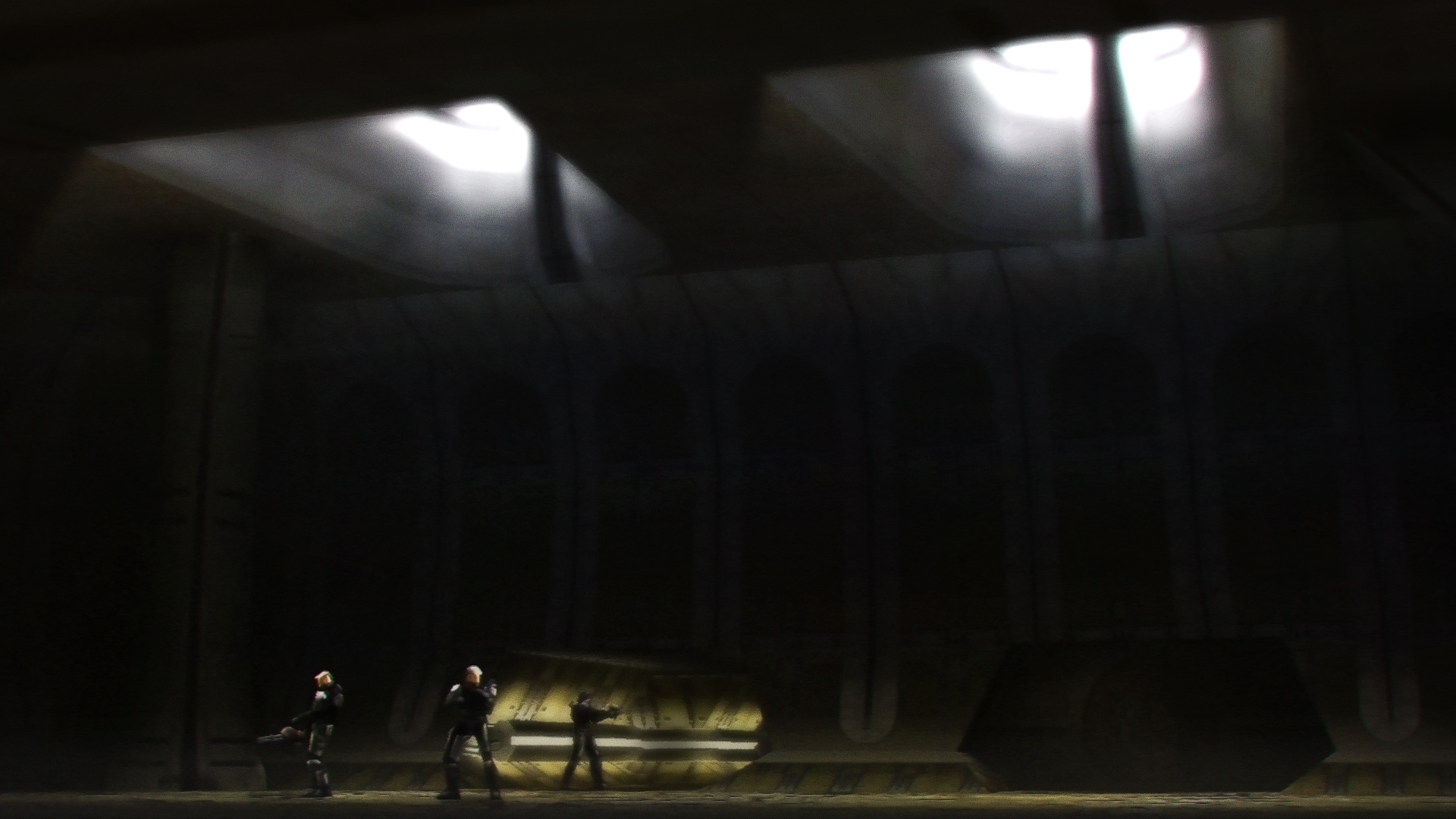
After Kenneth Peters provided us with an expansive background and some thoroughly detailed teasers on what the Digsite crews are working on in Part 1, we thought it would be good to start off with some Q&A before sharing some tales from the trenches.
Let’s roll out the proverbial red carpet and speak with General_101, Conscars (“Con”), Num0005, Scruffy, Sean T, Ludus, and Zeddikins.
Take a bow, gentlemen! Why don’t you introduce yourselves and tell us where we might know you from?
CON: Hey, I’m con. You can usually find me haunting the Halo modding Discords telling people to seal their open edges and check Sapien’s logs. Other than that, I maintain the c20 modding wiki and occasionally make maps.
GENERAL_101: How ya doing? I'm General_101 and you probably know me mostly for the Blender toolset. Shoutout to the Blender project!
[Ken note: General really needs no introduction to the Halo modding world, but I want to say that without his help there would almost certainly NOT be a Digsite crew, and even if there was, we would not even be close to having this content in a shippable state. So, if this work excites you, make sure you give a salute to your General.]
NUM0005: Hey y'all, I'm num0005, I started off modding Halo with making custom Halo 2 modding tools. These days I mostly maintain the Osoyoos mod tools launcher.
[Ken note: Num was the second “official” member of the Digsite crew, so he’s seen things both glorious and horrible in the recovered files that even the other crew were spared from. Check out his work on GitHub!]
SCRUFFY: Hi, my name is James but most people know me online as xScruffyDaSasquatchx or Scruffy. I am now one of the leads of the VKMT mapping team and am involved in several communities to help new modders and document the games. I am amazed and greatly excited by the opportunity to work on this project.
SEAN T: Hello, I’m Sean T. You may possibly know me for projects such as "Halo CE+” and other work done by my old mapping team, VKMT. I’m very excited to be part of this project and to share what I’ve been working on.
LUDUS: Hey, my name is John (a.k.a. Ludus online) and I’ve done art in various Halo mods such as "Halo CE+” and "Reach Evolved."
ZEDDIKINS: Hello, I'm Zedd, everyone's favorite infected Spartan wearing sunglasses. I maintain the modding tool Assembly and have been modding Halo for over a decade now. This has certainly been a unique opportunity that I happen to be well equipped for.
[Alex note: Giving my personal eternal gratitude to Zedd for giving us that Halo 4 campaign Theater mode mod a while back!]
Which is your favorite Halo game and why?
CON: It’s gotta be Halo: CE. It was the first PC shooter I really spent a lot of time in, and I first got into modding it around 2005, so it’s hugely nostalgic and replayable for me.
GENERAL_101: Halo 2, without a doubt. It was pretty much the first game I actually owned as a kid. In retrospect, I just enjoy how it presents itself compared to other games in the series. I loved the different perspective when you played as the Arbiter and how cutscenes were in done a movie like fashion. The intro to Outskirts or Sacred Icon is still great in my opinion, with all the set pieces. If it wasn't Halo 2 then it would probably be ODST. The soundtrack is amazing and having an official “survival mode” in a Halo game in the form of Firefight was so much fun. I still remember trying to get the VidMaster achievements on there.
NUM0005: Halo 2. ‘nuff said.
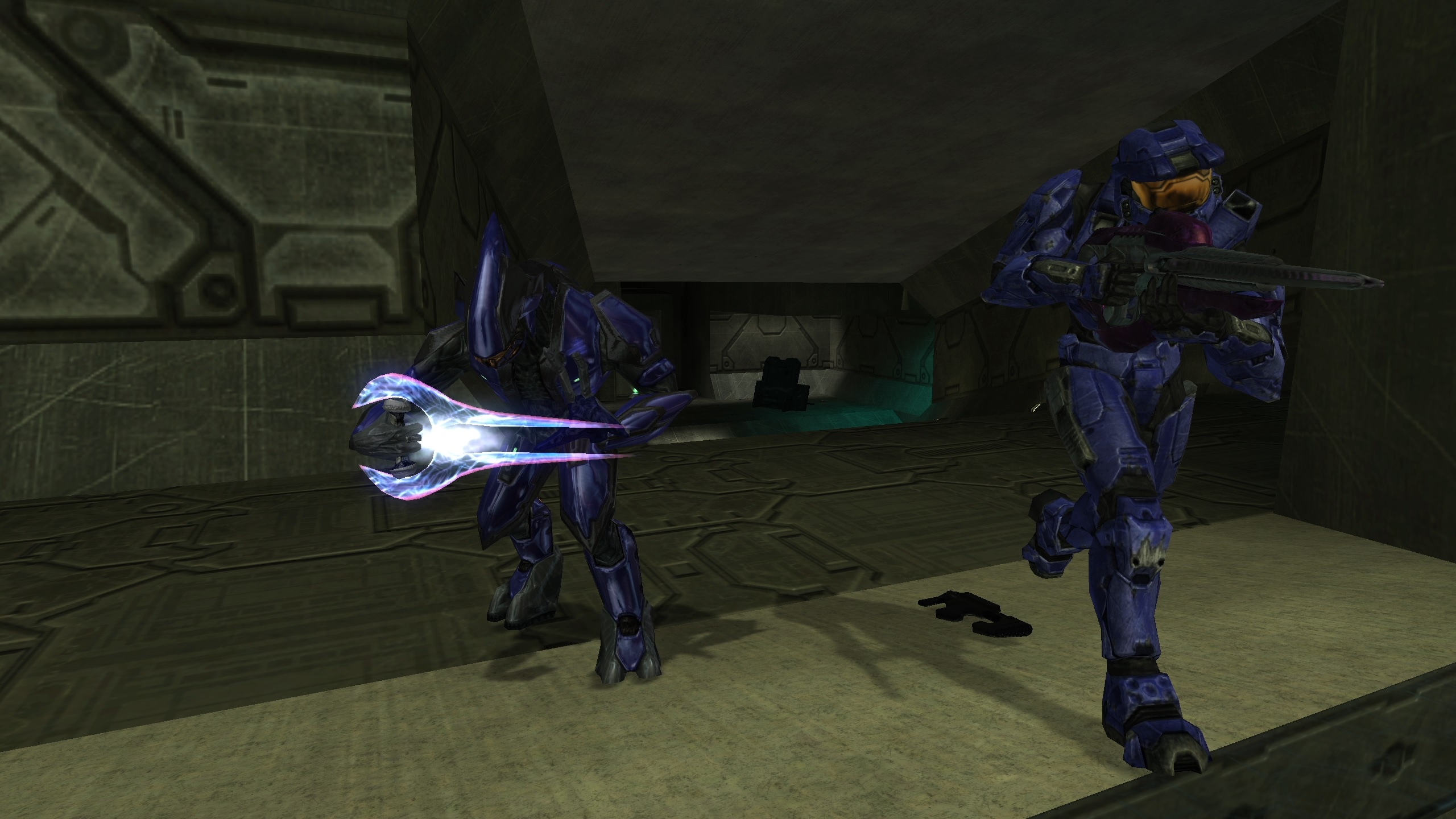
SCRUFFY: Halo 2 was my second shooter ever and remained one of my favorite games until Halo: Reach came out. I've sunk countless hours into its campaign, multiplayer, Forge, and even clan raids. I love the whole franchise and while I feel that the original trilogy comprises of the better games, there's something about H2 and Reach being the more flawed masterpieces of that era that interests me. Regardless I think the most desired games are always the ones we can't get, and wondering what a better, more perfect version of Halo 2 would be is most likely what sparked my interest in cut content.
SEAN T: My favorite Halo game is Halo 3: ODST, it’s a short and sweet campaign experience and it’s always a joy to replay with friends in co-op. ODST’s gameplay feels like an expansion of ideas introduced in Halo: CE while adding its own unique flair.
[Alex note: That mix of “greatest hits of Halo gameplay” in the flashback missions mixed with the lonely exploration of nighttime Mombasa is hard to beat!]
LUDUS: Halo: Combat Evolved. There is nothing like the precisely tuned combat rhythm of the game and levels like The Silent Cartographer are so familiar to me they feel like a second home. It also has my favorite art direction of the series.
ZEDDIKINS: I think that title goes to Reach, as it was what formally kicked off this modding hobby of mine. And being the first Halo to release since learning to drive meant being able to stand in line at midnight, then coming home to binge the campaign until the sun came up.
Of the material we have uncovered from the archives, which is the most interesting and exciting?
CON: There’s a lot of cool stuff being found, so it’s hard to just pick just one thing, but the unfinished levels have perhaps been the most intriguing to me. Halo: CE modders have been seeing hints of “swampthing”, “ruinedpain”, and “raceday” levels in tags for years without knowing what they were, but now they’ve been found.
Seeing the earliest iterations of The Silent Cartographer model was also really neat. I didn’t expect it started as a simple height map displacement. The shape of the island was mostly different but there are cliff contours in the shipped version that you can seemingly trace back to this old height map.
GENERAL_101: It's really hard to choose with the amount of content we have but I'd have to go with all the leftover content for Halo 2. Getting the cut levels running in modern MCC was an interesting challenge considering how ancient some of the data is. The scripts currently given out with the H2EK for E3 Earthcity for example wouldn't compile in retail, and once you get past that they do not behave exactly like the showcase. A lot of work had to be put in to try to get it to look closer to what was expected. I can't wait to see people playing it cooperatively. Should be fun to see people go through it for themselves.
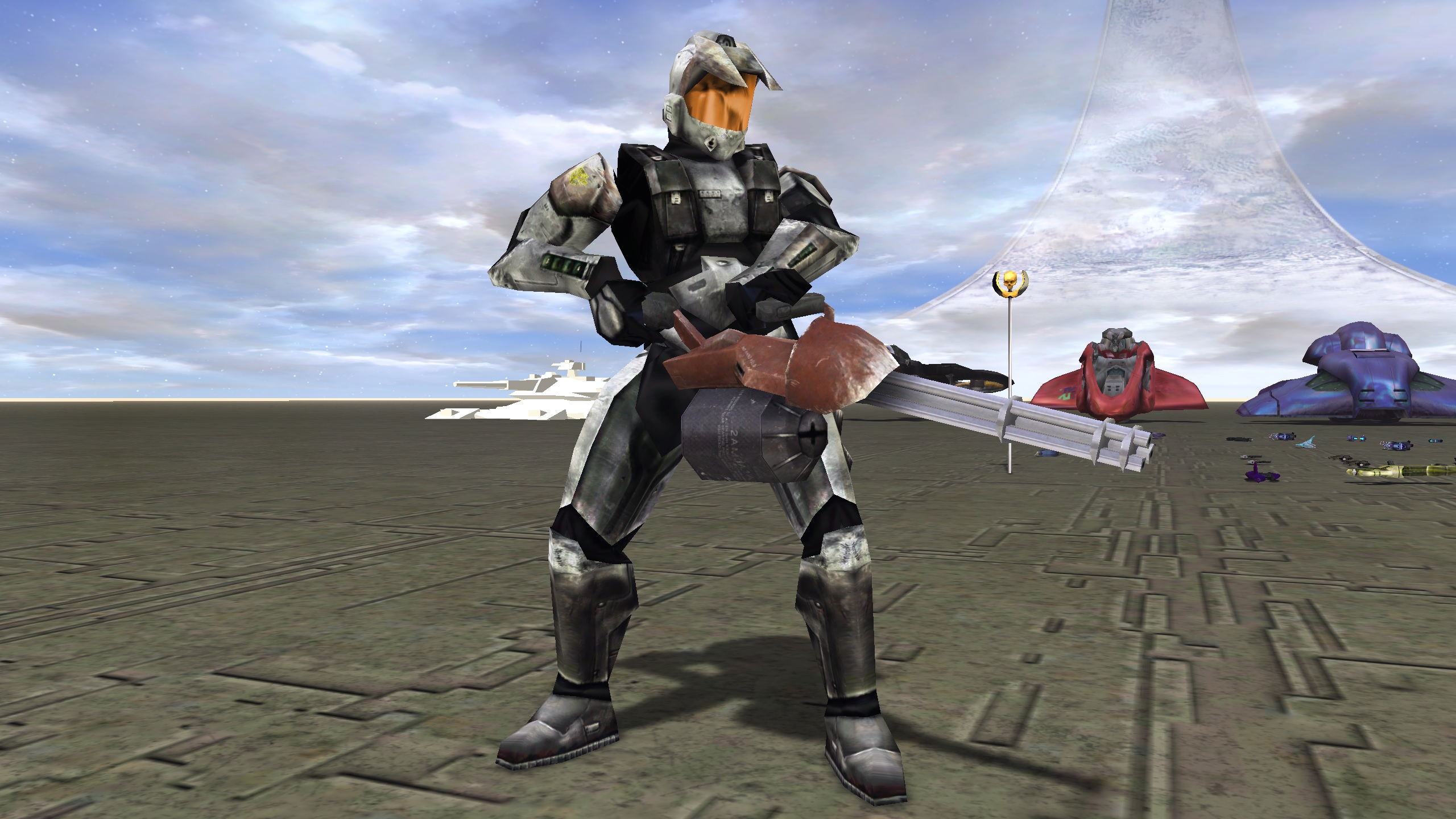
NUM0005: Gearbox-era multiplayer map design documents which describe various maps which were never polished for release, which has led me to wonder how different Halo: CE on PC would have been if different maps made the cut. I hope this project will allow us to see a glimpse of what it could have been.
A close second would be finding out the up until circa 2000, the engine exclusively used heightmaps called “islands” for its level terrain. Buildings were stored in a “tag” (game content file) called “structures.” The island system was dropped, but the structure system seems to have served as the basis (with heavy modifications!) for the eventual retail level geometry format. If anyone was wondering why Halo stores level geometry in “.scenario_structure_bsp” files, this might be why!
SCRUFFY: It's been an absolute joy finally being able to see all of this content up close. We've known for a while the existence of some assets from prerelease footage but what's even more interesting is the in-between transitional content that's never been seen by the public. A lot of it is in a really rough state but in some cases a clear timeline can be drawn detailing how a design changed over development.
SEAN T: There’s so much to pick here, and there’s always new content being found. I think the most interesting find is all the different aliens and weapons that are now being brought back.
LUDUS: I think the coolest discovery for me personally are all the things we didn’t know about prior, or things that were further developed than initially anticipated. Discovering things like the Doozy speedboat\jetski concept were actually 3d assets with textures was a trip for me.
ZEDDIKINS: Though my involvement has been limited to Halo 2, all the Halo: CE stuff I've seen and been able to test is amazing, the fact that this content even still exists is interesting as far as I'm concerned.
With that groundwork established, let’s talk to each of you on a more individual basis to learn about what you’ve been working on in this incredible project.
CON
In the reconstruction process, what do you consider your "specialty"?
My role so far has been to touch up incomplete assets. At the start of the dig, we had the chaingun model but there was no sign of its texture, so I volunteered to create a faithful recreation in glorious 512x512 resolution.
The original model's UV space was very underutilized and sharp edges needed adjustment, so I redid those prior to texturing. My recreation is based on what few screenshots and gameplay videos exist of the weapon, with some artistic liberties taken to fill in the gaps.
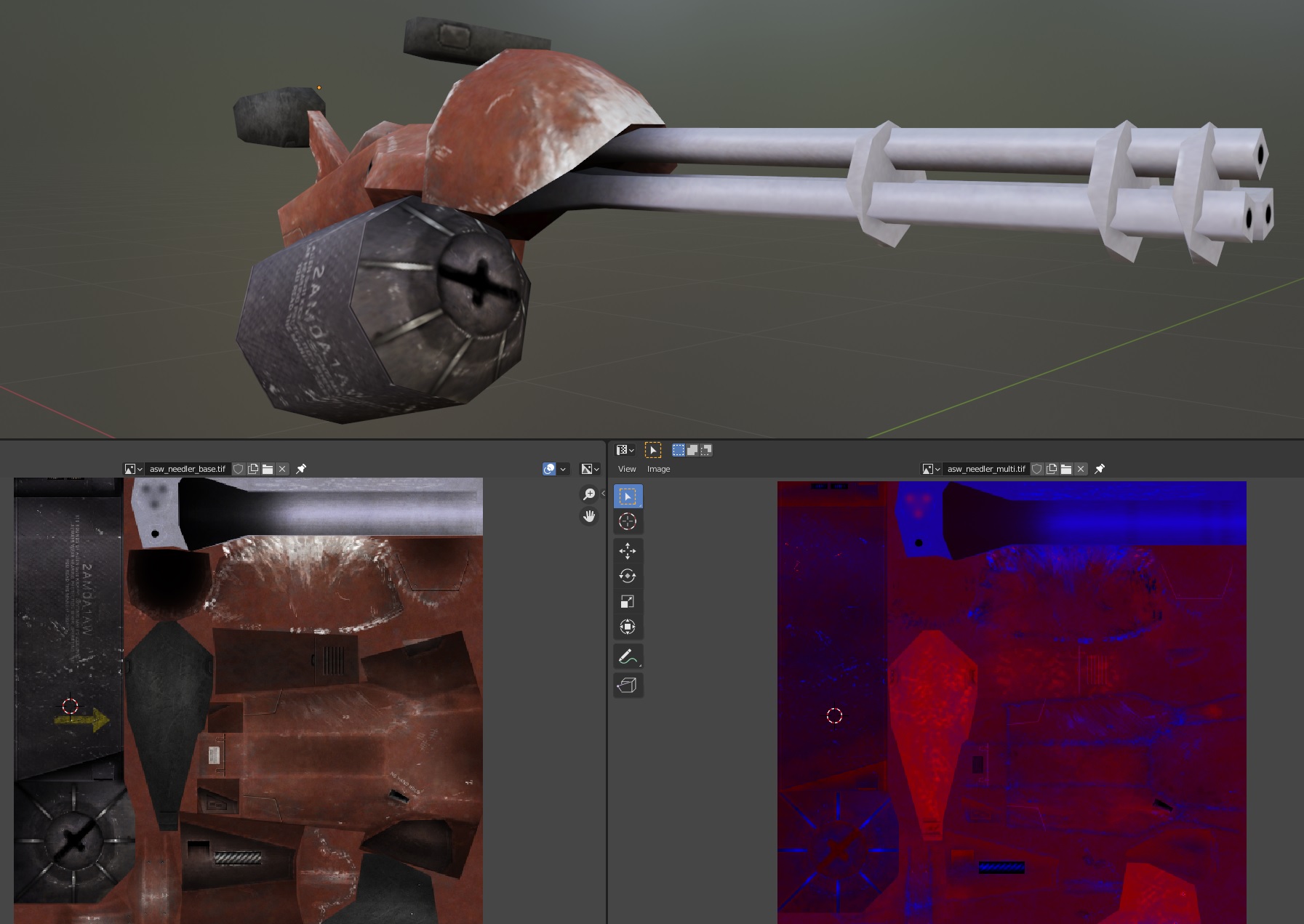
I’m currently working on a semi-custom level called Purgatory. In the Halo: CE 1749 beta [Alex note: gosh, this game was in development for a while!] people noticed that the level preview for Damnation looked like some ruined buildings on Reach. That was interesting, but hope dimmed of ever finding concrete information on what this was or was intended to be.
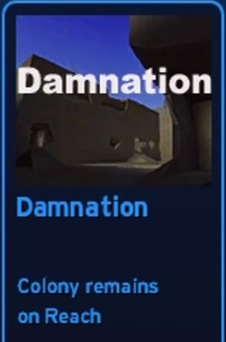
The model for this level was found. Actually… two completely different levels both called “ruined pain” were recovered, though both were barebones and still early in actual development. But they had so much “historical” interest we put a lot of work and focus on getting these stood up and playable.
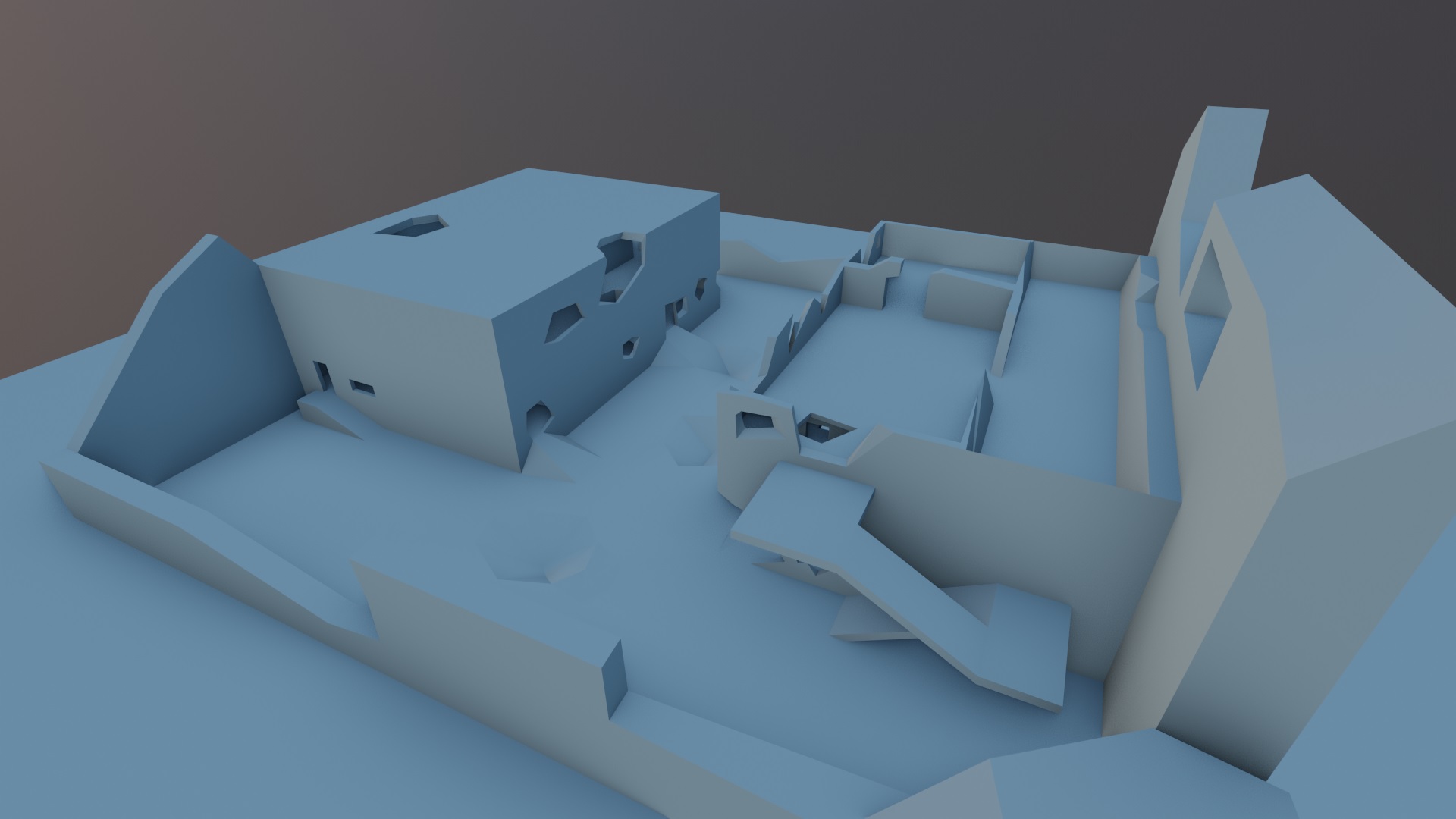
During a play test of it, folks commented that it felt like a faster-paced Boarding Action. The close quarters combat and taking potshots between the buildings was enjoyable, but the map wasn’t without its problems. The “no man’s land” in the middle is too punishing and the bases are too dissimilar to be seriously balanced; one has 3 floors and the other has 2, with completely different layouts.
The raw version of the map is interesting to see, but it’s exactly that: a raw, unfinished idea. The group wasn’t even sure it was worth restoring when there were much more complete levels available.
For that reason, though it was in the most danger of being left behind, and something about the idea of continuing its raw idea appealed to me. What would Reach even look like if it had been designed during the CE era? I am now creating a custom map based upon the original geometry. This includes new surroundings of a partially glassed city, a redesigned center, and modified bases.
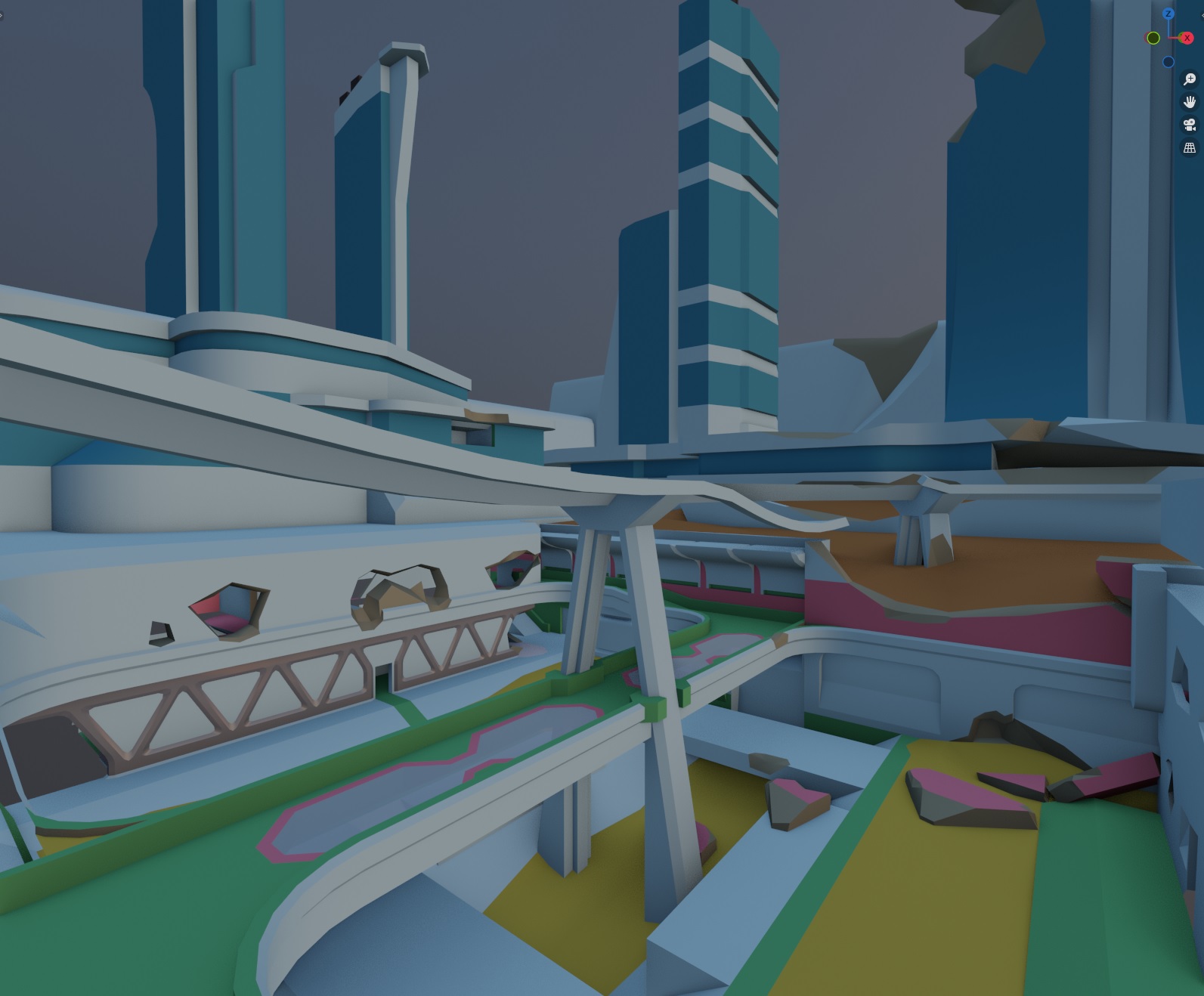
I’m using Reach concept art and kit bashing the original model to guide me and have the goal of reusing as much of the original as possible. Even parts I don’t use in the playable space may still end up in the ruins surrounding the map as an homage. I’m excited to continue modeling this map and have a lot of work ahead of me creating Reach-esque textures and the skybox, but this is turning out to be one of my all-time favorite projects.
[Ken note: Before people bombard me on Discord, the plan right now is to include Blender source for the two original, unmodified, ruined pain maps for others to analyze and remix.]
What was the most interesting thing you have learned from this work?
The sheer amount of content from the pre-release era surprised me the most.
Everyone knows there is cut content, but there are so many variations and iterations of weapons, characters, and vehicles that it truly demonstrates Bungie’s massive scope for Halo and the importance of experimentation to find the magic formula.
NUM0005
In the reconstruction process, what do you consider your "specialty"?
Data format and engine analysis. I designed part of the tooling used to extract content from very early builds of the game—specifically early textures and level data. A lot of this ended up being redundant as source files were found later but it provided a useful starting point.
What was the most interesting thing you have learned from this work?
Little tidbits about the history of the engine and how its design changed. When you mod CE it can seem like something that was designed in one go (apart from a few strange quirks), but this project has allowed me to appreciate just how in flux the engine was during its development. You see data formats and features supported change from build to build as the programmers adapted to changing design specs.
Can you tell our readers what the process for digging up an asset looks like?
Well, I’m glad you asked. It starts off with a build or asset being found somewhere in 343's vaults and getting passed to the group. From here, it can go a few different ways depending on the format it’s stored in.
If the Forerunners smile on us, files are found in what we call “source assets,” which are stored in common formats and can just be opened using the appropriate program. When this is possible it is the preferred approach as it preserves the most information. However, this is often not the case—many of the assets found do not have any associated source files. In these cases, we need to reconstruct the file.
This process begins with the tools team reviewing the file carefully. If we are lucky, it might be using the same format as the known game build or just a slightly modified one. If not it’s our job to work out the format. This can be quite tedious as it involves finding the nearest known format and working backward or forwards and finding all the changes Bungie developers made and it involves a lot of guesswork. This is the hardest part of the process.
In parallel with this process code is written for one of our internal tools to allow them to load this new format. Thankfully, while Bungie did change around a lot of the details of how various tags worked, the data we need to reconstruct the assets is quite basic and all the different format versions include it. At this point the updated tooling and extracted models can be shared with the rest of the group and iterated on. From beginning to end this can take anywhere from a few hours to over a week.
SCRUFFY
Why did you decide to focus on the recovered weapons?
While the rest of the team is focused on making sure these assets look good and can exist in the retail game, my main focus and expertise is porting/recreating the meta data of these files. What this means is once my team members have a weapon's model, textures, and animations in game, my job is to create the numbers and stats that dictate how that weapon will act. This covers everything from the weapon being able to fire a bullet in the first place, to finer details such as magazine size, recoil, bullet velocity and drop, and finally how much damage it does.
Getting as many cut weapons working as possible has been my number one priority, but I also work on vehicles and AI were applicable.
Did you learn anything particularly cool or exciting as part of this trip down Halo history?
The actual file structure of these old assets compared to retail has been a real trip learning. Those who are already familiar with modding Halo will know that to make a gun shoot you need to make a "weapon" that fires a "projectile" that does "damage."
In older versions it's a little different: an “object” creates an “item,” which creates an “item.weapon,” which creates a firing “effect.” That effect then creates another object which creates another item, it is then this projectile item which contains the data for damage done. Great care has gone into making sure the data is set up correctly in the newer engine instead of just being a simple drag and drop.
What design challenges have you faced working on these weapons?
So, one of the highlights of this project was working on the weapons featured in the 1999 footage fans are familiar with. However, what fans wouldn't know is just how incomplete these assets actually are.
Nearly all of the Covenant weapons are duplicates of the human files, just with appearance changes, and the human assault rifle is the only weapon that deals damage (plus any weapon that reuses its bullet file).
So, once I've recreated everything in this incomplete state, my job now becomes "what do I change, what do I add?" Change is a word that will upset a few when discussing the preservation of these files, but rest assured these are in no way overwriting the source files we have. We'd rather offer fun weapons and not duplicates, plus everything has to be balanced to not be too strong or too weak when paired with the retail weapons Halo: Combat Evolved provides.
With the human weapons being faithfully brought over this left a lot of room to get creative with the Covenant weapons. One weapon I'm proud of is the Concussion Gun, a recharging alien weapon that reuses the shotgun blast.
If I were to leave this weapon as-is it would be a clone of the human shotgun as well as the excavator. Instead, I opted to redesign the functionality of the gun to lean into its name and recreate a cut feature.
During the '99 development of Halo the player could crouch to charge a super jump. Since we are unable to modify the player with engine functionality that no longer exists, I gave the ability to the concussion gun. It can be used to reach the same heights as the super jump or used to push players, vehicles, and even thrown grenades around. It even counts as a melee so it's possible to back smack an unsuspecting opponent. I can't wait to see players have fun with these new toys.
What is your biggest takeaway lesson from this?
Just how far you can go if you're passionate about something. I started modding Halo in 2017 because I wanted to learn how to spawn a single cut character in Halo 2. From there I got involved with the community, developed my modding skills, and met a bunch of good people.
Once I realized I knew enough to start helping others everything sort of kept feeding into each other so that I kept learning new things and meeting new people. Eventually I found myself where I am now, with my character and talents valued enough to be a part of this project, all because I tried something new and stuck with it.
SEAN
In the reconstruction process, what do you consider your "specialty"?
My specialty on this project has been focused on art and animation. I’ve worked with the team to re-introduce the many variations of the Spartan back into Halo: CE with all the features you would expect (like player colors). I’ve also been working hard on the implementation for all sorts of additional content for the game, including the return of wildlife.
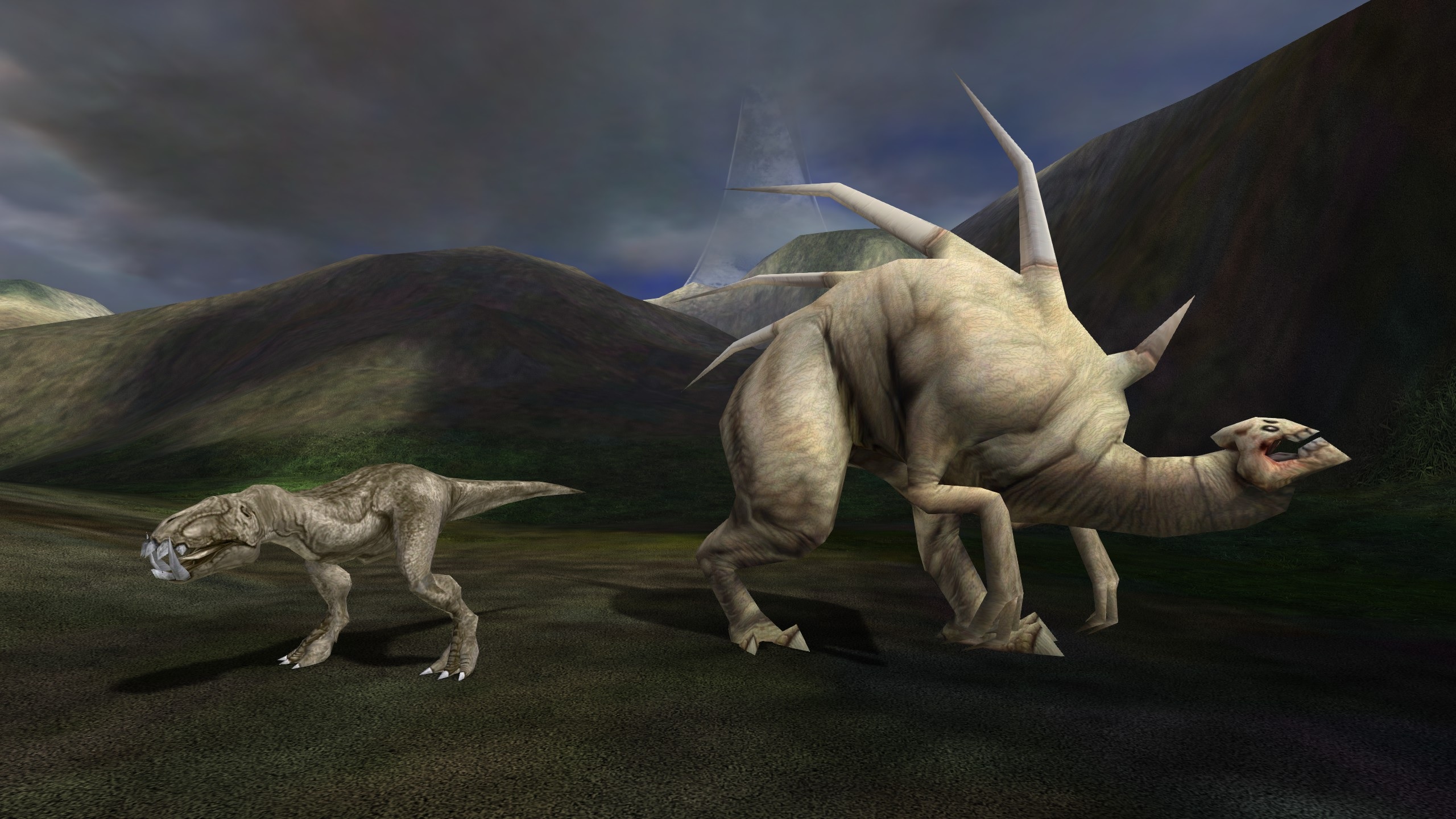
I’ve also been working on weapon related animations we have recovered, both third- and first-person.
The third-person animations seen above are all compatible with the retail CE Spartan. These will feature many other changes and improvements for the final version. Many of the third-person animations are based on files originally for the 1999 version of Halo.
Our first-person animations will be a mix of new and modified animations. For example, the chaingun is based on the flamethrower, but I’ve worked on adding many flourishes such as a spinning barrel.
What was the most interesting thing you have learned from this work?
I would have liked to think of myself as a “prerelease Halo expert” before joining this project due to the research I put into the game during my own modding projects, but there’s so much more to learn about the game and its history.
Nearly every day working on this project has been a new discovery about the history and origins of Halo, and it’s a rare glimpse into game development that few in the public ever get to see.
What's your favorite iteration of the cyborg biped you've worked on/learned exists?
My favorite iteration of the Spartan is one we haven't shown yet and has never been seen publicly.
It's a really cool design and I don't want to spoil it too much. All I'll say is if you love Mark V, Recon, or Scout, you'll be a fan!
As we move forward into new digsites, what is something that you can look back on and say you learned from this project?
For this project I was able to hone my skills in rigging, shader work and animation even further than in my previous works. It was also an opportunity for me to commit to using Blender for 3D work, which is something I've been trying to do ever since General's Blender tools were released.
What content have we not been able to find\fix\restore that will haunt your dreams?
Many fans of Halo 2 will be devastated to learn that there is no evidence of the famous cut level "forerunner tank" ever getting anywhere past the idea stage. No assets or documentation on this level has been found so far.
[Ken note: As Forerunner Tank is of fan interest, I want to emphasize “so far.” We are still looking for missing gaps in Halo 2 development files that may have included working assets for “Forerunner Tank,” Covenant Ship, and so on!]
JOHN HALO
In the reconstruction process, what do you consider your "specialty"?
My specialty is in art. I’m a bit of a generalist going between 3D model work in an application like Blender, painting textures by hand in Photoshop, or even going back and forth with Sean with how the materials should look in-engine using the mod tools like Guerilla. One of my jobs has been to upgrade assets to match the quality of the retail game.
While these weapon models hold up fine for their original intended use in third-person, it becomes apparent quickly that they were not meant to be seen super close up like you would in a first-person view. For first-person, I have made brand new models that match the quality of other weapons seen in Combat Evolved. I think this is best demonstrated with a couple of weapons:
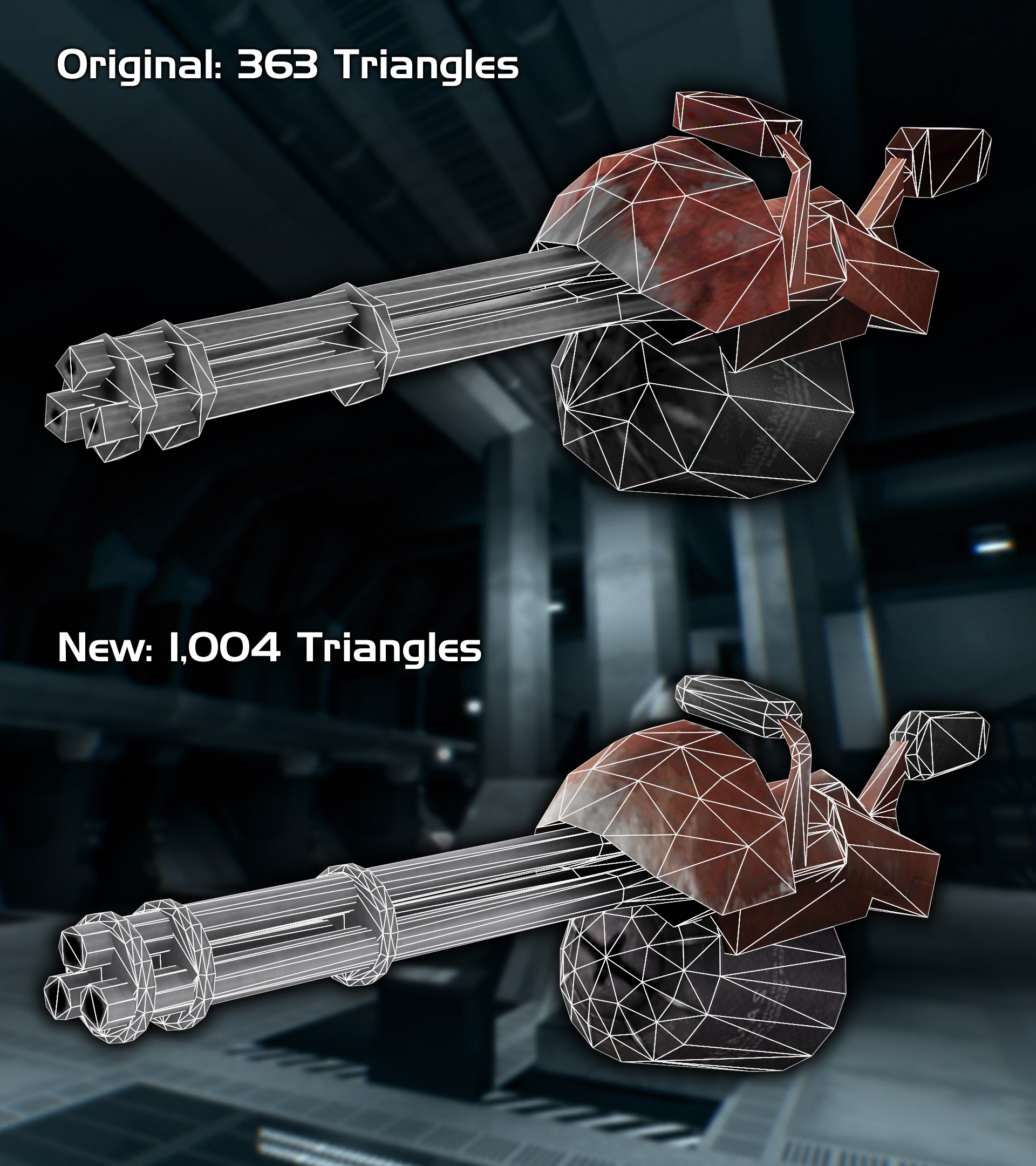
The Chaingun has a nearly 3x increase in geometry detail. This specific weapon is also using a brand-new texture from Conscars.
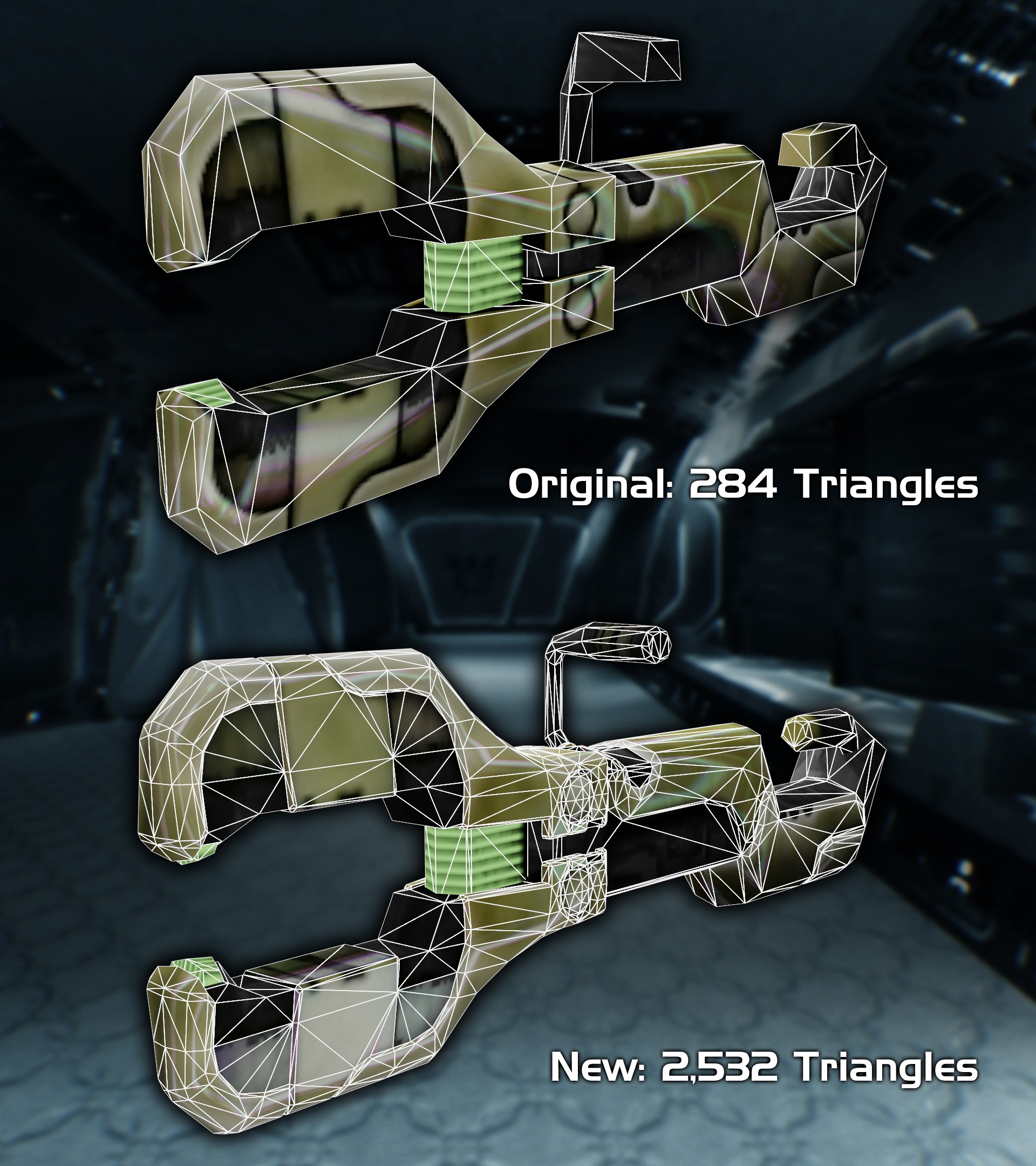
The Gravity Wrench was very enjoyable to model. Trying to maintain the overall shape while also modelling in some of the detail that is only really shown via the texture provided a fun challenge. I tried to make it smoother while still maintaining the overall silhouette and proportions. Personally, I am really happy with how this one turned out.
What was the most interesting thing you have learned from this work?
I think the most interesting thing to me was learning a bit of the process that went into the actual asset creation of these games. I felt giddy getting to dig through a simple photoshop file of a texture layer by layer. It gives a huge insight into how they created a lot of the game assets back then.
I already know the answer, but for the folks at home: What content have we not been able to find\fix\restore that will haunt your dreams?
Space Luger, no contest. I'm not sure if that is the actual name but I've been lovingly referring to it as such for years now.
It is actually a suppressed handgun with a miniature version of the 2000-era sniper scope. We haven't found the model yet, but I pray that we will. We did find the texture so maybe there still is hope. Until we find it, this gun will haunt me.
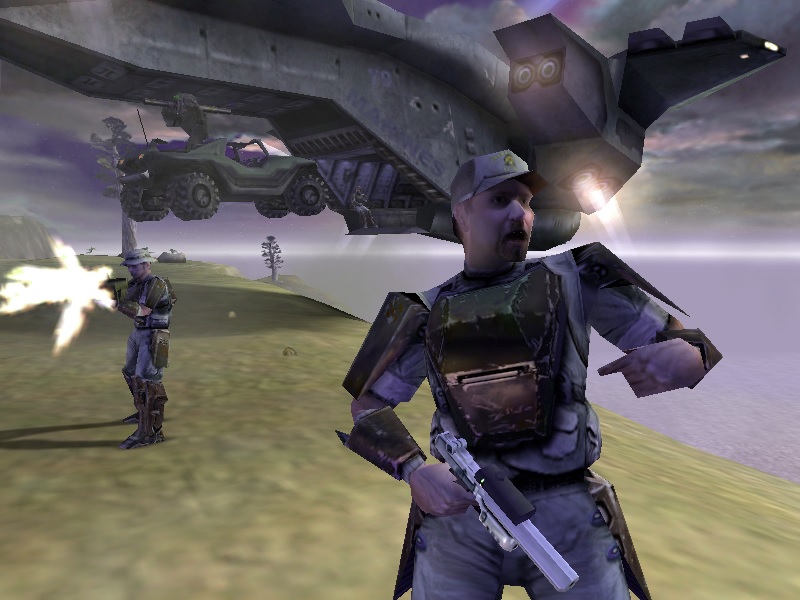
[Ken note: As seen in this classic marketing shot, Marcus gets all the cool toys, even in the 26th century! Believe me, if we find that pistol even a Covenant invasion would not be able to stop John from telling the entire world. And yes, we are working on the early variant of the Warthog seen in the background.]
ZEDDIKINS
In the reconstruction process, what do you consider your "specialty"?
My specialty is the engine's compiled map files themselves. Sometimes map files are the only available option for certain content so being able to get these old maps opened in various tools for analysis and resource extraction is a big help to the other folks getting this content re-implemented in MCC.
Now that we are revealing Alphamoon restoration is on our worktable, we should also say that the team is recording actual “final” dialog for various characters in that scenario. So… what's it like being a Heretic Elite?
So, while we may have the original temp dialogue for a mission through extraction or otherwise, it is not usable for legal and practical reasons. To get around this, myself and others have lent our voices to re-record any temp lines so that they are cool for public use.
Of the options given, I chose a Heretic Elite. It was a fun change of pace being able to do this, even if I may not be the greatest voice actor.
GENERAL_101
In the reconstruction process, what do you consider your "specialty"?
It's pretty hard to pin something down here since I try to be a jack-of-all-trades with varying degrees of success. If I had to pick something, I feel like I got a decent ability to get the tools we need to work with ancient content and get it working decently in the modern era.
One example is researching how constraint support should be handled in the Blender toolset in order to support exporting the physics data needed for the cut Shade walker in Halo 3. Working on that thing was fun and I hope people can see it completed one day (with less glitchy animations, at least).
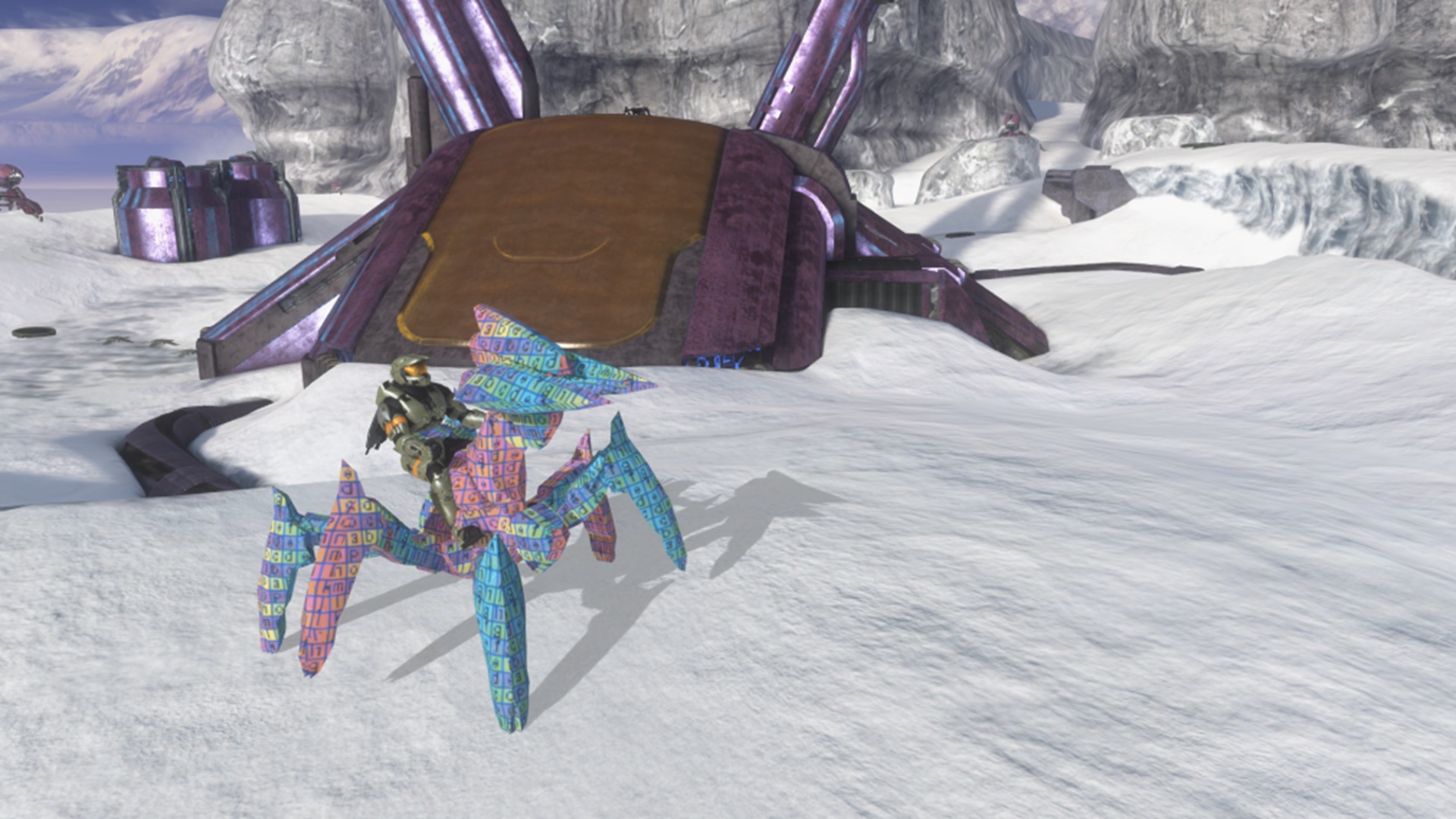
What was the most interesting thing you have learned from this work?
Probably how to work with binary files from the editing tools. It's not something I thought I would ever dive into since I didn't feel like there was any point.
When Ken showed us ancient Halo tags with no real way to check out the contents, it became pretty obvious that would have to change, quickly. Probably the fastest I've seen the group mobilize on a goal. We got some pretty decent results, though we are always striving to improve on the analysis and recompilation process.
Sounds like you've been busy. Any hopes you have for the content that comes out?
I really hope people take the content that comes out and mess with it plenty. I would love to see what the community could do to remix and reuse the content in their own projects.
Show me your playthroughs of Alphamoon and Earthcity, or how you use the CE content when they come out!
SECOND MOVEMENT OF THE ODYSSEY
And so, our second of this three-part series comes to a close. You’ve met the modders, you know what they’ve been working on, and hopefully what they’ve had to say has made you grin like a thorn beast who’s just learned it’s been saved from a firefight and being restored!
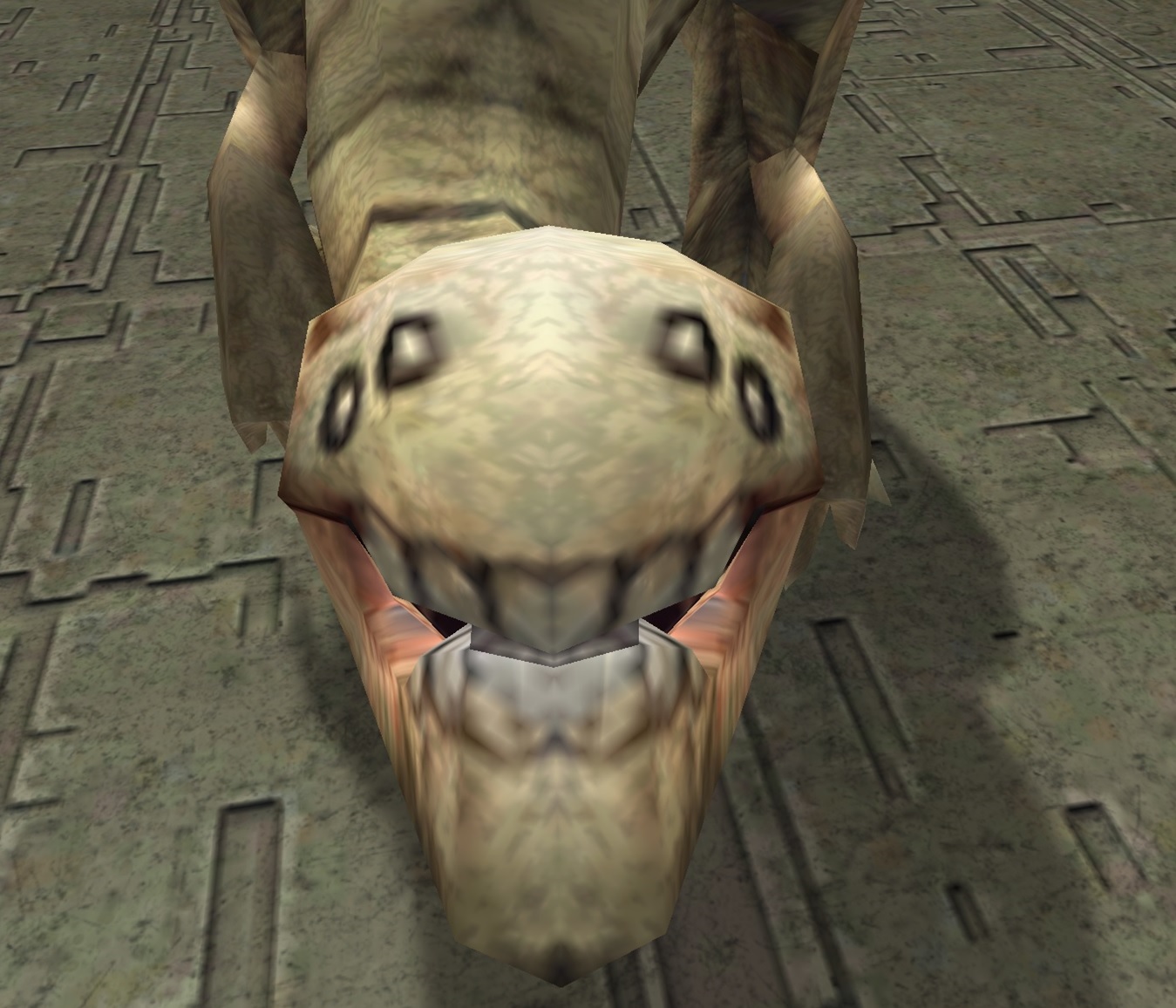
Our third and final part will be a special Canon Fodder issue releasing towards the end of this month which will explore some of these things as true fictional elements in the Halo universe—a cutting room floor encyclopedia of sorts, if you will!
Until then, let’s give it up for the Digsite modders who have been driving this project and given us their time for this Q&A. Their work signals the culmination of one of the greatest journeys in Halo’s storied history, taking us back to times and places that have lived in obscurity for... well, decades, if you can believe it.
And we can’t wait for more of our players to be empowered with the tools to explore and build upon that legacy themselves.





